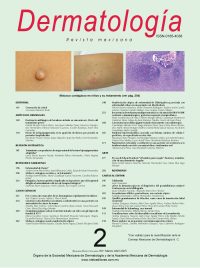Recurrence of metastatic malignant melanoma with BRAF V600E mutation resistant to immunotherapy and subsequent response to target therapy.
Dermatol Rev Mex. 2025; 69 (2): 253-259. https://doi.org/10.24245/dermatolrevmex.v69i2.10446
Paola Scarlett Díaz De Alba,1 Gilberto Morgan Villela,2 Guadalupe Montserrat Gutiérrez Mota,2 Felipe de Jesús Ramírez,3 Paulina García de León Flores1
1 Médico pasante del servicio social, Guadalajara, Jalisco, México.
2 Médico oncólogo, práctica privada, Guadalajara, Jalisco, México.
3 Médico cirujano, práctica privada, Guadalajara, Jalisco, México.
Resumen
ANTECEDENTES: A lo largo de décadas recientes la incidencia de melanoma cutáneo ha ido en aumento en el mundo en poblaciones con fototipo Fitzpatrick I y II. Los pacientes con enfermedad metastásica han tenido pronósticos desfavorables y las oportunidades terapéuticas han sido limitadas. En melanomas primarios y metastásicos, BRAF es el oncogén mutado encontrado con mayor frecuencia en casi el 50% de los casos. Las metástasis linfáticas regionales son comunes en el melanoma y pueden encontrarse en proximidad al tumor original o a lo largo del trayecto entre el tumor y los ganglios regionales. También se disemina a través de la vía hemática y afecta principalmente los pulmones, el hígado, el cerebro, la piel y los huesos. La tasa de supervivencia a cinco años varía según el grado de afectación ganglionar.
CASO CLÍNICO: Paciente femenina de 47 años con diagnóstico de melanoma maligno nodular con mutación del gen BRAF V600E/EC en la región femoral de la pierna derecha, tratado con resección quirúrgica. Tuvo metástasis en el útero y el pulmón. Inicialmente no respondió a la inmunoterapia con pembrolizumab e ipilimumab-nivolumab. Sin embargo, logró una respuesta completa sostenida al recibir terapia dirigida con dabrafenib-trametinib.
CONCLUSIONES: Las terapias inmunológicas han mejorado significativamente la supervivencia de los pacientes con melanoma metastásico; no obstante, la respuesta terapéutica puede variar entre pacientes. La paciente del caso requirió un tratamiento alternativo, como la terapia dirigida, para lograr una respuesta óptima.
PALABRAS CLAVE: Melanoma maligno; inmunoterapia; BRAF; mutación.
Abstract
BACKGROUND: The incidence of cutaneous melanoma has been increasing worldwide over recent decades in populations with Fitzpatrick phototype I and II. Patients with metastatic disease have had poor prognosis and therapeutic opportunities have been limited. In primary and metastatic melanomas, BRAF is the most frequently mutated oncogene found in almost 50% of cases. Regional lymphatic metastases are common in melanoma and may be found in proximity to the original tumor or along the pathway between the tumor and regional nodes. It also can spread through the bloodstream and mainly affect the lungs, liver, brain, skin, and bones. The 5-year survival rate varies according to the degree of lymph node involvement.
CLINICAL CASE: A 47-year-old female patient with diagnosis of nodular malignant melanoma with BRAF-V600E/EC mutation in the femoral region of the right leg, treated with surgical resection. She presented metastasis in the uterus and lungs. Initially, she did not respond to immunotherapy with pembrolizumab and ipilimumab-nivolumab. However, she achieved a sustained complete response when receiving targeted therapy with dabrafenib-trametinib.
CONCLUSIONS: Immunologic therapies have significantly improved the survival of patients with metastatic melanoma; however, the therapeutic response may vary among patients. The patient described required alternative treatment, such as targeted therapy, to achieve an optimal response.
KEYWORDS: Malignant melanoma; Immunotherapy; BRAF; Mutation.
https://orcid.org/0009-0004-4129-097X
https://orcid.org/0000-0003-1688-7171
Recibido: marzo 2023
Aceptado: agosto 2023
Este artículo debe citarse como: Díaz-De Alba PS, Morgan-Villela G, Gutiérrez-Mota GM, Ramírez FJ, García de León-Flores P. Recurrencia de melanoma maligno metastásico con mutación BRAF V600E resistente a inmunoterapia y posterior respuesta a terapia blanco. Dermatol Rev Mex 2025; 69 (2): 253-259.

